Top Tips For Recovering From A Cycling Injury
Having an injury is frustrating, especially when it takes you away from your favourite activities such a jumping on the bike and getting out for a ride. Unfortunately, they can’t always be avoided, but there are some things you can do to streamline the recovery process and give yourself the best chance of getting back on the bike as soon as possible.
With our friends from Barefoot Physiotherapy, we are pleased to share the following tips for helping you recover from an injury and get back out on your bike. As always, these tips are a guide only and you should seek professional advice for serious injuries, ifthe pain is persistent and getting worse or if any of these exercises are causing more pain. Now, on with the tips.
Gentle movement
We often think that what an injury needs is complete rest to allow it to recover. While we certainly want to avoid aggravating movements, often total rest is not the correct answer either. There are obvious exceptions to this, but most muscle and joints aches or pains do best with a ‘gentle movement’ or relative rest approach.
For example – lower back pain is common in cyclist, so while you might need to take a short period of time off the bike, doing pain free supported lower back movements are ideal for calming down the area, reducing the threat messages from the area and encouraging the body to move as much as it comfortably can.
- Cat-cow is a perfect example of this – on hands and knees dropping the belly down, then lifting up into a curled spine. Just doing what range is comfortable and pain free for 5-10 repetitions.
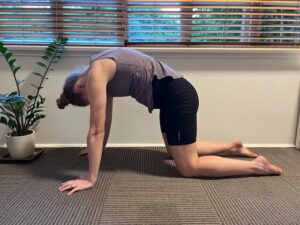
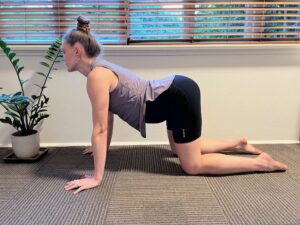
- Hip shifts is another good option – on hands and knees and taking the hips to one side and then the other, allowing the spine to gently curve to the sides for 5-10 reps per side
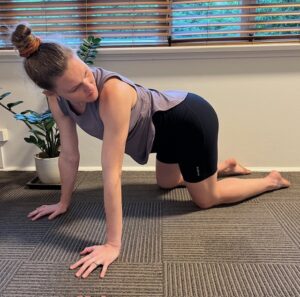
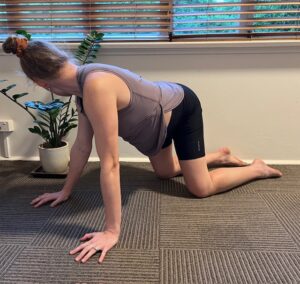
Releases
Many common muscle and joint injuries arise as a result of accumulative strain (ie a slow build-up of strain or tension over time) – although some may be the result of very sudden strain build up (like coming off your bike!). Either way, reducing muscle tightness or tension can often help to ease the movement restrictions and improve pain free mobility. Here are two good options for common cycling areas of discomfort
- Glute release – great for hip or lower back issues. Either lying on the floor or standing against a wall. Place a firm ball in the glute muscle (top of your pelvis at the back, around to the side of your hip and down to your buttock). You’re aiming to find a ‘trigger point’ – the ball will feel like it is pushing against resistance (something firm like a “knot” or “band” in the muscle. Move around or change the angle of your hips to help you search the muscle for these spots. Once you find one, stay on it for 60-90 seconds then find another one, you want to release a total of 3 spots.
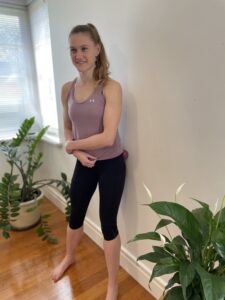
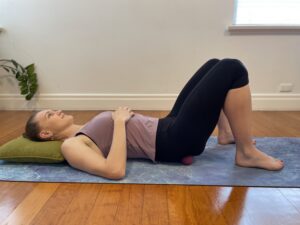
- Infraspinatus release – good for neck or shoulder issues. The muscle you are aiming for is on the back of the shoulder blade. Bring one of your arms across your body, and place the ball on the back of that shoulder blade. Lean up against a wall to push the ball into this muscle. Roll the ball on the wall pushing into the muscle. Try to find a spot in the muscle where your ball feels like it is pushing against resistance (something firm like a “knot” or “band” in the muscle). Once you find one, stay on it for 60-90 seconds then find another one, you want to release a total of 3 spots
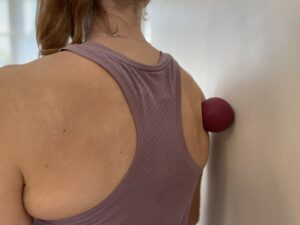
Set yourself up for success
Often an injury is a marker of the body not being happy. That gradual build-up of strain that leads to most injuries (aside from crashes) needs to be dealt with if you want to give yourself the best opportunity to recover and repent future injury. This can look like:
- Cross training off the bike until your body is moving and feeling better – for example swimming to avoid too much hip bending or cycling on a stationary set up where you can sit more upright to take pressure off your lower back
- Getting your bike set-up checked – ensuring your bike is well set-up for your body and how you ride is really important for your longevity and overall musculoskeletal health. Most bike shops will be able to help you with this
- Ensure your whole body is moving well – often the area of symptoms can be the result of tightness elsewhere in the body. Likewise, an injury can cause compensation in the body that contributes to future problems. Seeing a holistic physiotherapist that can assess your movements, muscles and joints to get you moving as well as possible is ideal for your injury recovery and prevention.
We strongly recommend getting professional assistance for any injury recovery to ensure you are working on the right areas and doing any exercises properly for a swift recovery. Great phsysiotherapists, like the team at Barefoot, are highly experienced in identifying the source of your pain and coming up with a unique plan to help address your issues.
In the meantime, give the tips above a go even if you don’t have an injury – they will help your overall wellbeing – and then check out our other post on exercises for injury prevention and strength building. As we’ve all heard, an ounce of prevention is worth a pound of cure … or is that now 28.4 grams of prevention is worth 0.45 kilograms of cure?
Also, please check out Barefoot’s blog site for a wealth of other information, advice and people stories as well as check out the services and holistic approach they employ.

